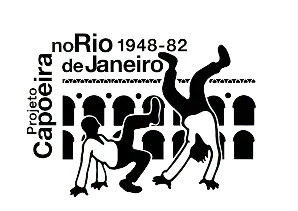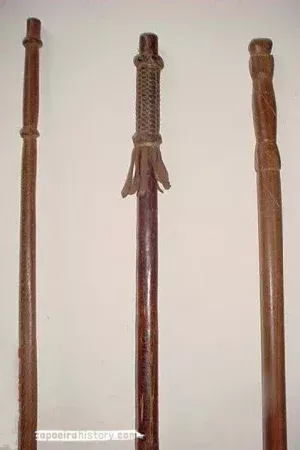Ah Mundo Barquisimeto: A Provisional History of Garrote – part 1
By Michael J. Ryan
What is Garrote?
Swinging a hardwood stick at somebody was once the principal response among Venezuelan men who felt disrespected, their hospitality or ancestry abused, or their property under threat. Other times, men swung their sticks at each other to raise a ruckus, pass the time, and sometimes even pay homage to a local saint. The braided handled walking stick, known as a garrote or a palo, was once part of the everyday dress of Venezuelan males from the early 19th century to the mid-20th century. In midwestern Venezuela, by the time the 1950s came about, these once fearsome weapons were increasingly retired from being carried in public as being an outlandish and slightly embarrassing symbol of an earlier rougher time. Nevertheless, among those who appreciate its efficacy and cherish its traditions, the palo continues to be strapped underneath a moped, laid in the trunk of a car, or hidden behind the front door of a house, ready to be used if the situation calls for it. The garrote was always more than just a mere tool, but has long been immersed in a constellation of local meanings, symbols, and principles. For many years, the public display of one’s palo communicated to the world that here walked a man of honor who had been taught right from wrong and could take care of himself.
In today’s Venezuela, the terms garrote or juegos de palos refer to stick fighting and, more specifically, to a distinctly Venezuelan form of armed combat. The art of garrote principally revolves around using a walking-sized stick, but it also covers a variety of occupational tools that can double as weapons. Depending on the time, region, repertoire, skill of the teacher, or the trustworthiness of the student, a garrotero can also be skilled in fencing with the rapier, military saber, machete, machete and a knife in each hand, a whip and a knife in each hand or the knife alone. Some garroteros were also well-versed in using the lance or the whip, suggesting roots in older Western European herding cultures. Additionally, those trained in garrote were often comfortable using their empty hands like weapons and had a command of some basic disarms, standing grappling, trips, and sweeps.
Garrote, everyday life and the Tamunangue
The first accounts of garrote as a weapon appear around Barquisimeto in the early 19th century. Local biographers, chroniclers, and government records show stick, machete, and saber fighting was a widespread and acceptable way to settle disputes in the civil sphere or to resort to during the innumerable political conflicts that racked Venezuela through the 19th and early 20th century. In the early 20th century, garrote became associated in the region around Lara state with a local ritual dedicated to Saint Anthony of Padua.
Oral histories often relate that garrote was a recreational male pastime and part of everyday leisure life. During their off-hours men would drink, gamble, and engage in other risky behaviors meant to show off their fearlessness and skill in front of their family, friends, and neighborhood. Dueling like this in a public site, allowed older community members to exercise some form of physical or moral restraining influence on the participants. In this way the risk-oriented ultra-machismo attitudes of young men could be legitmated as part of village culture but held in check form breaking out into unrestrained violence which could destroy village society through feuding and vendettas. That is not to say that men did not take the opportunity to resolve grudges and feuds during local festivals or that grand melees did not break out because they did. However, there was a greater tolerance of the ludic aspects of violence, and the predominance of sticks as the principal weapon acted as a form of a cultural check on unrestrained violence.
What is so interesting about the manifestation of garrote is that when folklorists and journalists first began turning their attention towards garrote in the 1930s, it was part of a multi-day festival known as the Sones de Negros done in Barquisimeto, Carora, as well as the small towns and villages around the area. By then, the ritual had begun to become more formalized and uniform and take shape in the form we see today.
At present, every year, during the first weekend in June, a series of five to seven dances are done to make a promise or to give thanks to Saint Anthony. Proceeding a series of ritual dances is a performative oriented armed duel known as La Batalla done with thin hardwood sticks, dull machetes of 30 inches in length, or 12-inch fixed-handled knives. For those interested in combative traditions, what is interesting about La Batalla, though, is how all the old men say La Batalla is not a dance done between a man or a woman as seen in the rest of the ritual but a duel between men, even though increasingly women take part in it. Second, up through the middle of the 20th century, La Batalla took place with thick, heavy sticks, razor-sharp machetes, lances, whips, and knives. In fact, in the smaller little towns, those men who have had too much to drink will, in good high spirits will, pull out their thick, heavy, beveled fighting sticks and belabor each other mercilessly to the horror and embarrassment of much of the crowd until they can be broken up. Others equally impaired and feeling disrespected while taking part in La Batalla or harboring some long-held grudges will pull out machetes and knives and fight until some braver souls can find a pole or two to pry them apart. In Barquisimeto, one of the two major urban areas in the region, the Tamunangue is still done with machete and knives (albeit dull). Here, the way the Tamunangue is done provides a glimpse back into a once more perilous and bloodier past where the Saint was propitiated with the shedding of blood. The occasional outbreaks of real ludic or antagonistic violence in the working-class barrios of the larger urban areas or smaller villages supports the idea that La Batalla was once separate from the ritual honoring of Saint Anthony. Then, sometime in the early 20th century, it was co-opted into the ritual and reduced to a purely performative, non-contact folk dance.
The popularity of garrote and the ritual dances associated with Saint Anthony began soon after World War Two when a newly democratic civilian government came into power. Seeking to solidify their mandate, the new government tried to wield the diverse populations of Venezuela into a single nation. For centuries, many communities throughout Latin America saw themselves as members of a family, a clan, a neighborhood, a province, or a religion, but never as a citizen of a nation; that was something new and unfamiliar. As part of this nation-building effort, state officials working with local scholars and other elites co-opted a local celebration dedicated to Saint Anthony of Padua and renamed it the Tamunangue. With only wishful thinking and trite ethnographic research supporting their claims, the government claimed the Fiesta de San Antonio resulted from the blend of Indian, African, and European cultures.
In the same way, the Tamunangue blended the musical instruments and dances of three peoples, Indian, African, and European, who live in Venezuela; through the centuries, these three peoples also mixed with each other over time to make the population racially indistinguishable. Everybody was the same, a citizen of the Venezuelan nation. Such an origin myth regarding the racial homogeneity of a country is common throughout Latin America and has served to sidestep the racism, oppression, and greed of those who rule.
Despite the co-optation of a local civilian combative art into the political discourse of nationalism and its reduction to a folkloric performance, Garrote still exists; it is still cherished and still practiced as a combative art meant to take out a threat in an economical, efficient, and culturally approved manner. In the next section, we will look at the development of garrote in the city of Barquisimeto..
In the next post we will see the development of the garrote in the city of Barquisimeto.

Michael J. Ryan holds a PhD from the Anthropology Department at Binghamton University, New York, United States and is a practitioner of garrote
Bibliography
Assunção, Matthias Röhrig. “Juegos de Palo in Lara. Elementos para la história social de un arte marcial venezolano”. Revista de Indias, LIX, 215 (1999): 55-89, Madrid. (ISSN: 0034-8341).
Canelón, Jesus. “El Juego de Garrote.” Fermentum. Revista Venezolana de Sociología y Antropología, 4, 10. Mérida, 1994, p.22-32.
Gonzales, Argimiro. Enciclopedia autodidáctica sobre el Juego de Garrote venezolano. Barquisimeto (?), Ministerio del Poder Popular para la Cultura, Consejo Autónomo de Cultura del Estado Lara (CONCULTURA) etc, 2007.
Gonzales, Argimiro. El juego del garrote Tocuyano. El Tocuyo (Lara), 1995.
Ryan, Michael J. Venezuelan Stick Fighting: The Civilizing Process in Martial Arts. Lanham, MD: Lexington Books, 2016
Ryan, Michael J. “I Did Not Return a Master, But Well Cudgeled Was I: The Role of ‘Body Techniques’ in the Transmission of Venezuelan Stick and Machete Fighting.” The Journal of Latin American and Caribbean Anthropology, Vol. 16, 1 (2011), pp. 1-23.
Ryan, Michael J. “Does anybody here want to fight’… ‘No, not really, but if you care to take a swing at me…’: the cultivation of a warrior’s habitus in a Venezuelan combative art.” Ido Movement for Culture. Journal of Martial Arts Anthropology. Vol. 15. No.3 (2015) . pp.1-7.
Ryan, Michael J. “Pueblo Street-Fighting to National Martial Art: The Politics of Tradition and the Nationalization of a Venezuelan Civilian Combative Practice”. American Ethnologist, Vol. 39. No.3 (2011), pp. 531-547.
Ryan, Michael J. “Garrote de Lara: The Development of a Creole Armed Combat from the Pueblos of Venezuela.” The Latin Americanist. Vol. 55. No. 3 (2011). pp. 67-92. DOI: 10.1111/j.1935- 4940.2011.01122
Sanoja, Eduardo. Juego de garrote larense. El método venezolano de defensa pessoal. Caracas: Federación Nacional de la Cultura Popular, 1984.
Sanoja, Eduardo. Juego de Palos o Juego de Garrote. Guía bibliohemerográfica para su estudio. Los Rastrojos (Lara), Asociación Venezolana de Jugadores de Garrote, Patio de Garrote Clarencio Flores, 1996.
Sanoja, Eduardo e Zerpa, Irene. El Garrote en nuestras letras. Los Rastrojos (Lara), Tallerers tiográficos de Miguel Angel García e Hijo, 1990.







